Analysis of Managerial Behavior, Agency Costs, Ownership Structure
VerifiedAdded on 2020/05/16
|10
|2783
|149
Essay
AI Summary
This essay provides an in-depth analysis of agency costs, managerial behavior, and ownership structure, drawing from the "Theory of the Firm" article. It explores the core concepts of agency theory, including the principal-agent problem and how it affects decision-making within a company. The essay examines the impact of outside equity and debt on agency costs, detailing how managerial decisions can diverge from shareholder interests, leading to potential inefficiencies. It discusses the role of monitoring, bonding, and corporate ownership structure in mitigating these costs. Furthermore, the essay investigates the agency costs associated with both equity and debt financing, highlighting the incentives and behaviors of managers and owners. The analysis covers how corporate ownership structure affects financial decisions, the impact of sales-to-asset turnover, free cash flow, and growth opportunities. The conclusion emphasizes the importance of understanding agency theory for effective financial management and corporate governance. The paper also explores how debt financing and the incentives of owner-managers influence corporate behavior, including investment decisions, monitoring, and the overall wealth of the company.
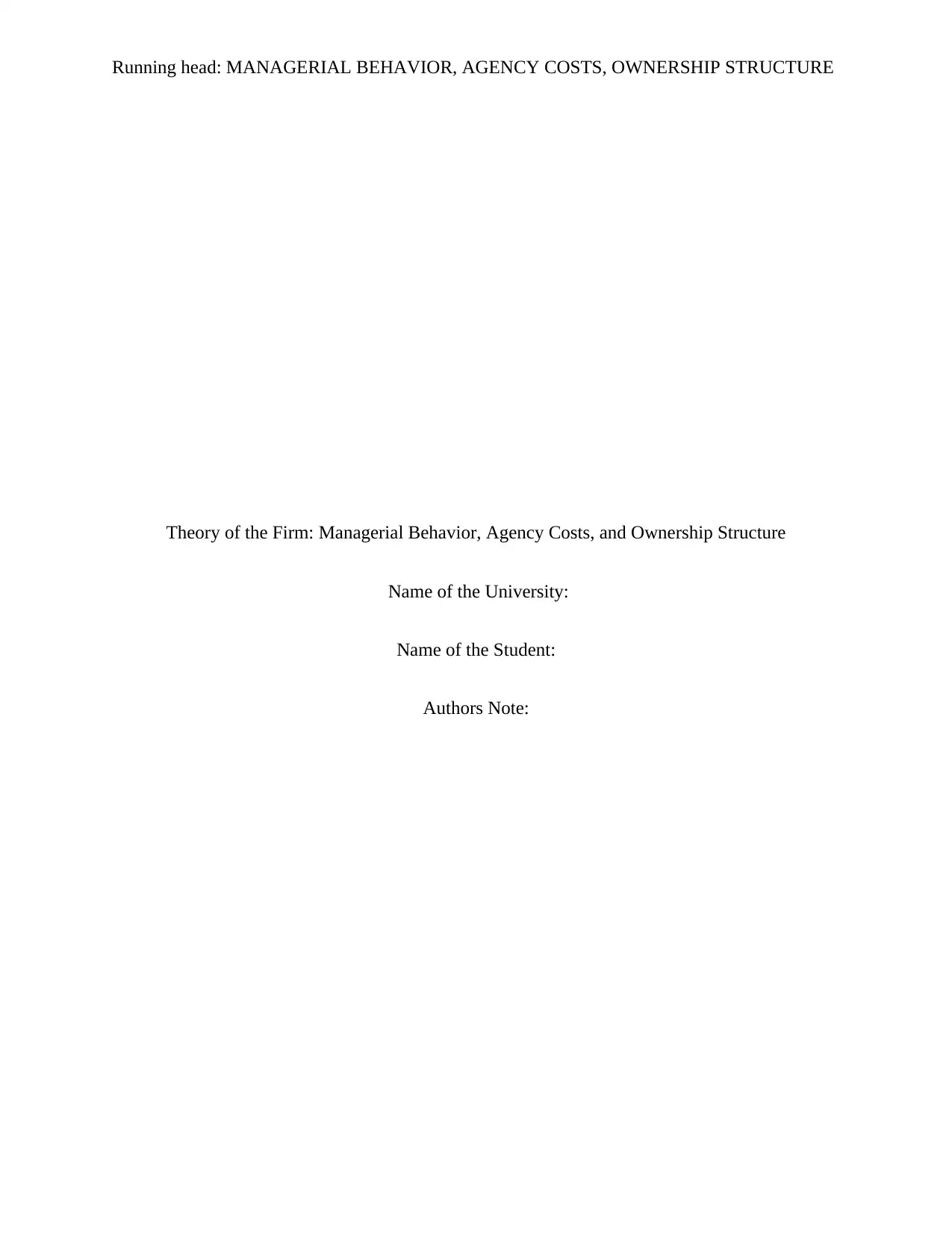
Running head: MANAGERIAL BEHAVIOR, AGENCY COSTS, OWNERSHIP STRUCTURE
Theory of the Firm: Managerial Behavior, Agency Costs, and Ownership Structure
Name of the University:
Name of the Student:
Authors Note:
Theory of the Firm: Managerial Behavior, Agency Costs, and Ownership Structure
Name of the University:
Name of the Student:
Authors Note:
Paraphrase This Document
Need a fresh take? Get an instant paraphrase of this document with our AI Paraphraser
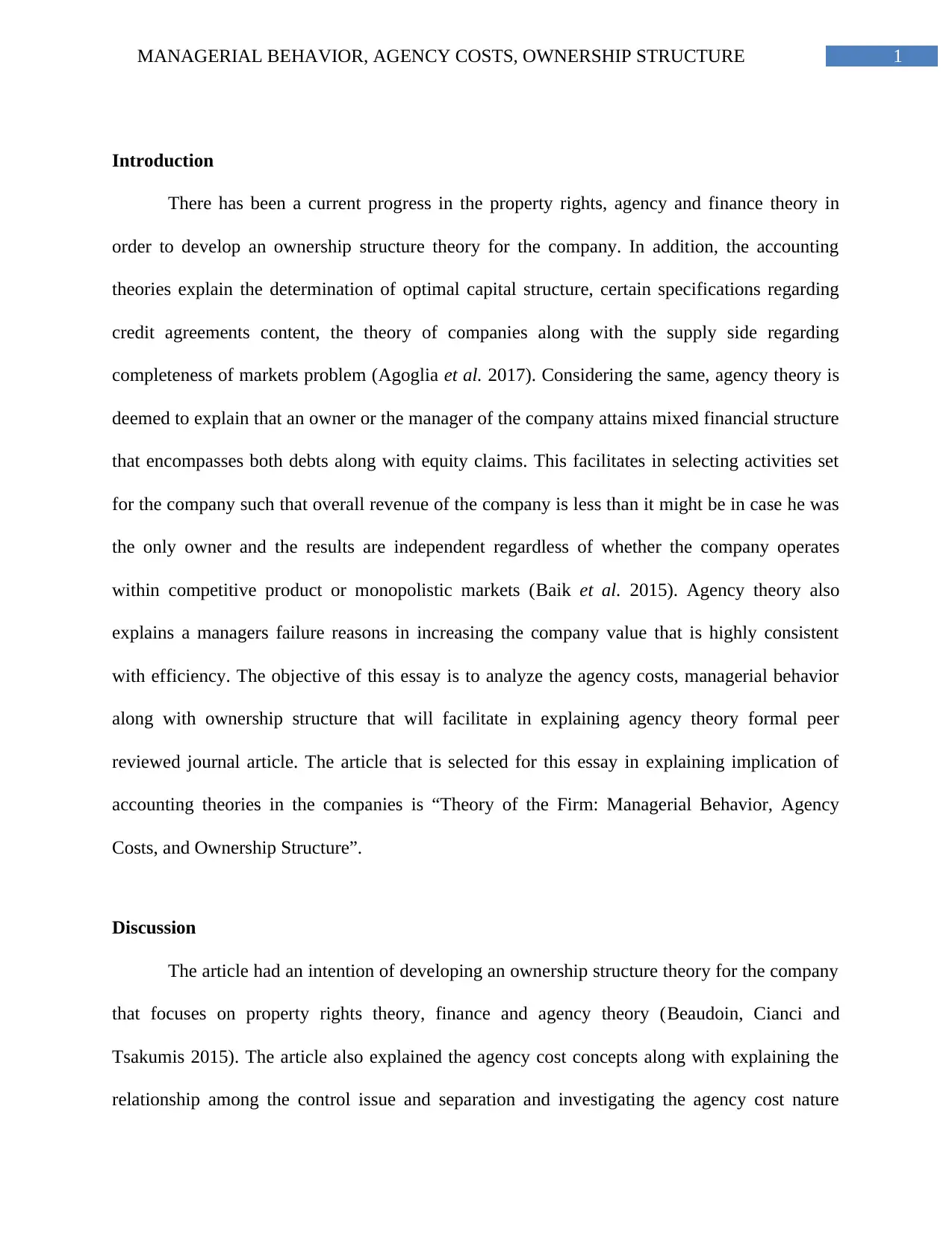
1MANAGERIAL BEHAVIOR, AGENCY COSTS, OWNERSHIP STRUCTURE
Introduction
There has been a current progress in the property rights, agency and finance theory in
order to develop an ownership structure theory for the company. In addition, the accounting
theories explain the determination of optimal capital structure, certain specifications regarding
credit agreements content, the theory of companies along with the supply side regarding
completeness of markets problem (Agoglia et al. 2017). Considering the same, agency theory is
deemed to explain that an owner or the manager of the company attains mixed financial structure
that encompasses both debts along with equity claims. This facilitates in selecting activities set
for the company such that overall revenue of the company is less than it might be in case he was
the only owner and the results are independent regardless of whether the company operates
within competitive product or monopolistic markets (Baik et al. 2015). Agency theory also
explains a managers failure reasons in increasing the company value that is highly consistent
with efficiency. The objective of this essay is to analyze the agency costs, managerial behavior
along with ownership structure that will facilitate in explaining agency theory formal peer
reviewed journal article. The article that is selected for this essay in explaining implication of
accounting theories in the companies is “Theory of the Firm: Managerial Behavior, Agency
Costs, and Ownership Structure”.
Discussion
The article had an intention of developing an ownership structure theory for the company
that focuses on property rights theory, finance and agency theory (Beaudoin, Cianci and
Tsakumis 2015). The article also explained the agency cost concepts along with explaining the
relationship among the control issue and separation and investigating the agency cost nature
Introduction
There has been a current progress in the property rights, agency and finance theory in
order to develop an ownership structure theory for the company. In addition, the accounting
theories explain the determination of optimal capital structure, certain specifications regarding
credit agreements content, the theory of companies along with the supply side regarding
completeness of markets problem (Agoglia et al. 2017). Considering the same, agency theory is
deemed to explain that an owner or the manager of the company attains mixed financial structure
that encompasses both debts along with equity claims. This facilitates in selecting activities set
for the company such that overall revenue of the company is less than it might be in case he was
the only owner and the results are independent regardless of whether the company operates
within competitive product or monopolistic markets (Baik et al. 2015). Agency theory also
explains a managers failure reasons in increasing the company value that is highly consistent
with efficiency. The objective of this essay is to analyze the agency costs, managerial behavior
along with ownership structure that will facilitate in explaining agency theory formal peer
reviewed journal article. The article that is selected for this essay in explaining implication of
accounting theories in the companies is “Theory of the Firm: Managerial Behavior, Agency
Costs, and Ownership Structure”.
Discussion
The article had an intention of developing an ownership structure theory for the company
that focuses on property rights theory, finance and agency theory (Beaudoin, Cianci and
Tsakumis 2015). The article also explained the agency cost concepts along with explaining the
relationship among the control issue and separation and investigating the agency cost nature
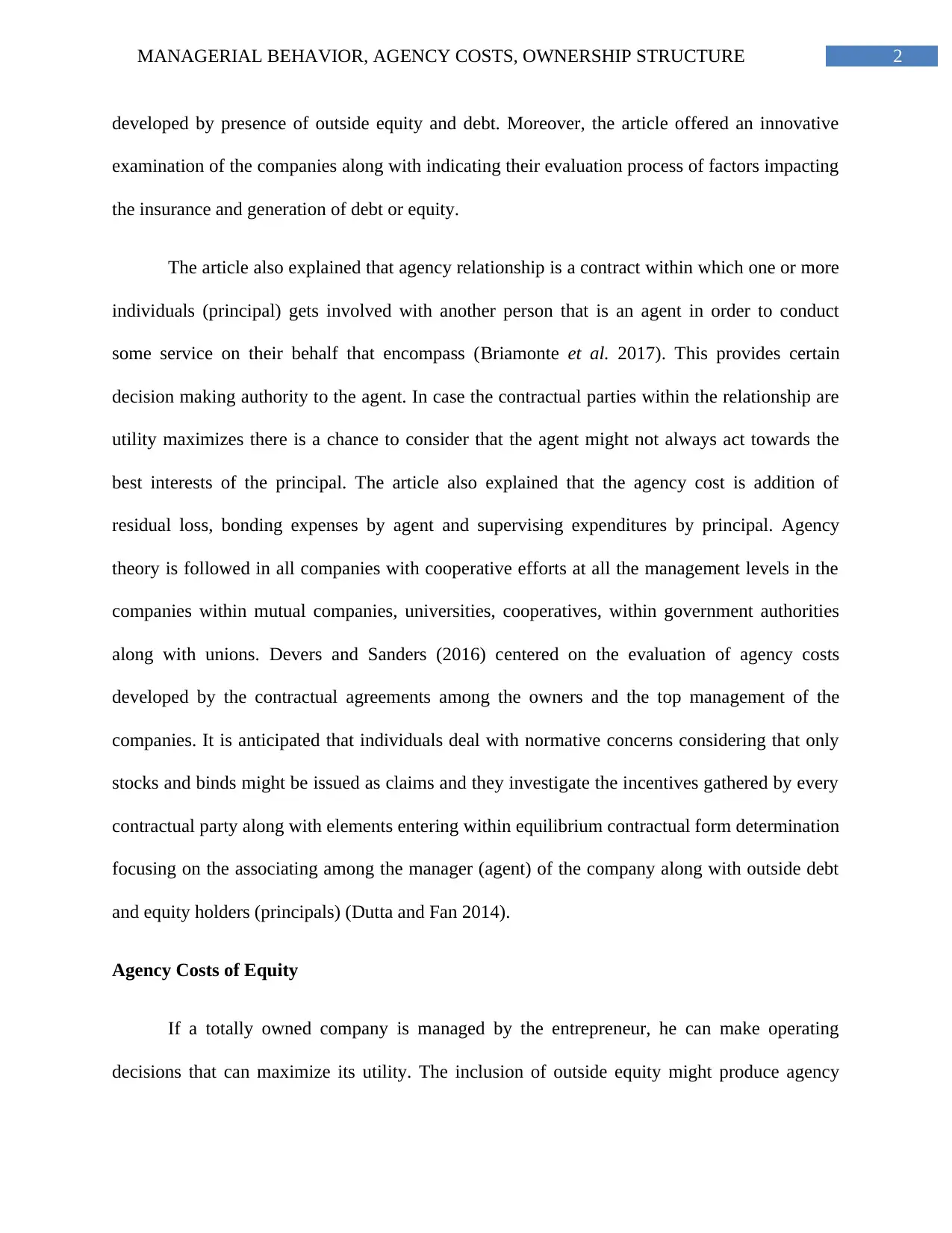
2MANAGERIAL BEHAVIOR, AGENCY COSTS, OWNERSHIP STRUCTURE
developed by presence of outside equity and debt. Moreover, the article offered an innovative
examination of the companies along with indicating their evaluation process of factors impacting
the insurance and generation of debt or equity.
The article also explained that agency relationship is a contract within which one or more
individuals (principal) gets involved with another person that is an agent in order to conduct
some service on their behalf that encompass (Briamonte et al. 2017). This provides certain
decision making authority to the agent. In case the contractual parties within the relationship are
utility maximizes there is a chance to consider that the agent might not always act towards the
best interests of the principal. The article also explained that the agency cost is addition of
residual loss, bonding expenses by agent and supervising expenditures by principal. Agency
theory is followed in all companies with cooperative efforts at all the management levels in the
companies within mutual companies, universities, cooperatives, within government authorities
along with unions. Devers and Sanders (2016) centered on the evaluation of agency costs
developed by the contractual agreements among the owners and the top management of the
companies. It is anticipated that individuals deal with normative concerns considering that only
stocks and binds might be issued as claims and they investigate the incentives gathered by every
contractual party along with elements entering within equilibrium contractual form determination
focusing on the associating among the manager (agent) of the company along with outside debt
and equity holders (principals) (Dutta and Fan 2014).
Agency Costs of Equity
If a totally owned company is managed by the entrepreneur, he can make operating
decisions that can maximize its utility. The inclusion of outside equity might produce agency
developed by presence of outside equity and debt. Moreover, the article offered an innovative
examination of the companies along with indicating their evaluation process of factors impacting
the insurance and generation of debt or equity.
The article also explained that agency relationship is a contract within which one or more
individuals (principal) gets involved with another person that is an agent in order to conduct
some service on their behalf that encompass (Briamonte et al. 2017). This provides certain
decision making authority to the agent. In case the contractual parties within the relationship are
utility maximizes there is a chance to consider that the agent might not always act towards the
best interests of the principal. The article also explained that the agency cost is addition of
residual loss, bonding expenses by agent and supervising expenditures by principal. Agency
theory is followed in all companies with cooperative efforts at all the management levels in the
companies within mutual companies, universities, cooperatives, within government authorities
along with unions. Devers and Sanders (2016) centered on the evaluation of agency costs
developed by the contractual agreements among the owners and the top management of the
companies. It is anticipated that individuals deal with normative concerns considering that only
stocks and binds might be issued as claims and they investigate the incentives gathered by every
contractual party along with elements entering within equilibrium contractual form determination
focusing on the associating among the manager (agent) of the company along with outside debt
and equity holders (principals) (Dutta and Fan 2014).
Agency Costs of Equity
If a totally owned company is managed by the entrepreneur, he can make operating
decisions that can maximize its utility. The inclusion of outside equity might produce agency
⊘ This is a preview!⊘
Do you want full access?
Subscribe today to unlock all pages.

Trusted by 1+ million students worldwide
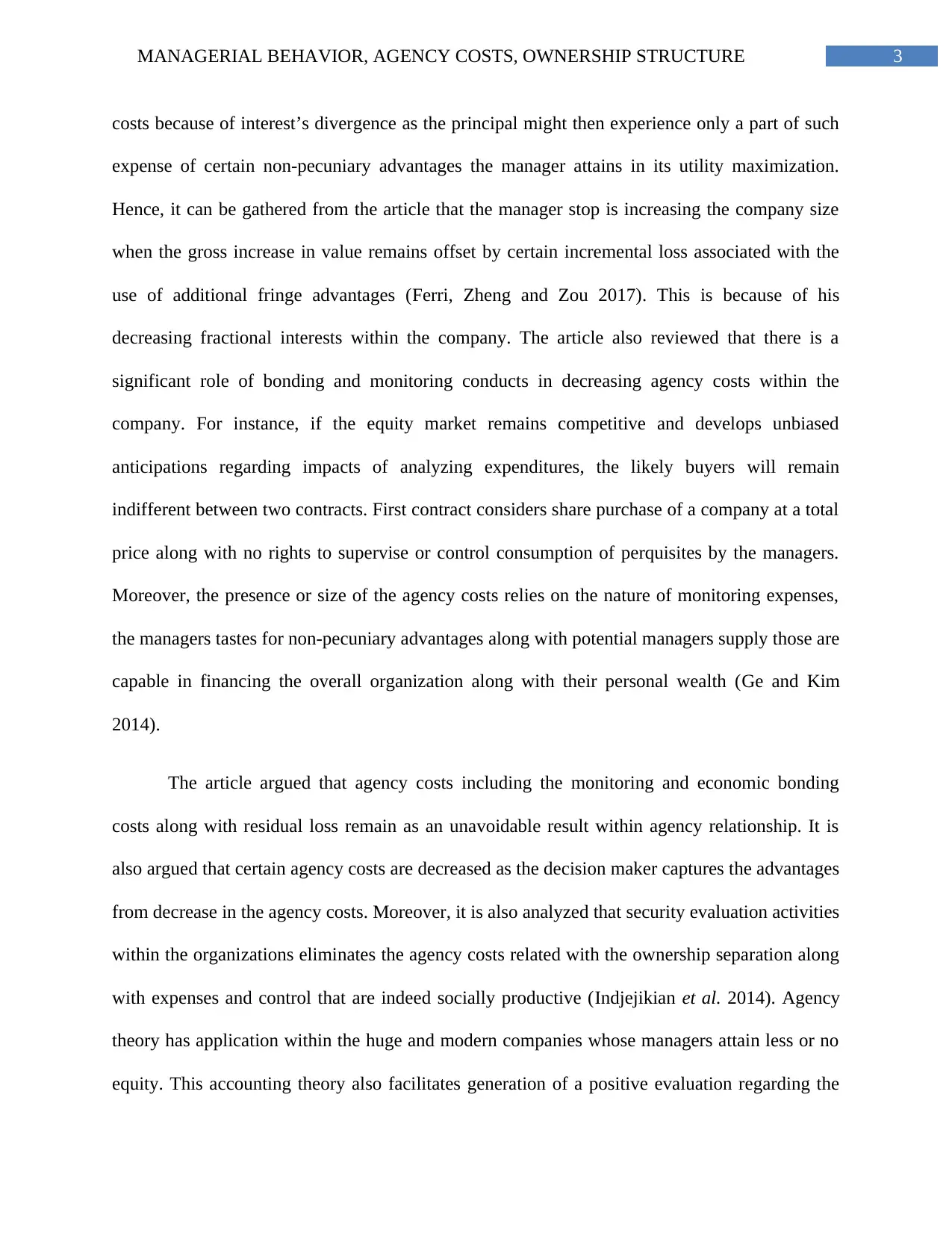
3MANAGERIAL BEHAVIOR, AGENCY COSTS, OWNERSHIP STRUCTURE
costs because of interest’s divergence as the principal might then experience only a part of such
expense of certain non-pecuniary advantages the manager attains in its utility maximization.
Hence, it can be gathered from the article that the manager stop is increasing the company size
when the gross increase in value remains offset by certain incremental loss associated with the
use of additional fringe advantages (Ferri, Zheng and Zou 2017). This is because of his
decreasing fractional interests within the company. The article also reviewed that there is a
significant role of bonding and monitoring conducts in decreasing agency costs within the
company. For instance, if the equity market remains competitive and develops unbiased
anticipations regarding impacts of analyzing expenditures, the likely buyers will remain
indifferent between two contracts. First contract considers share purchase of a company at a total
price along with no rights to supervise or control consumption of perquisites by the managers.
Moreover, the presence or size of the agency costs relies on the nature of monitoring expenses,
the managers tastes for non-pecuniary advantages along with potential managers supply those are
capable in financing the overall organization along with their personal wealth (Ge and Kim
2014).
The article argued that agency costs including the monitoring and economic bonding
costs along with residual loss remain as an unavoidable result within agency relationship. It is
also argued that certain agency costs are decreased as the decision maker captures the advantages
from decrease in the agency costs. Moreover, it is also analyzed that security evaluation activities
within the organizations eliminates the agency costs related with the ownership separation along
with expenses and control that are indeed socially productive (Indjejikian et al. 2014). Agency
theory has application within the huge and modern companies whose managers attain less or no
equity. This accounting theory also facilitates generation of a positive evaluation regarding the
costs because of interest’s divergence as the principal might then experience only a part of such
expense of certain non-pecuniary advantages the manager attains in its utility maximization.
Hence, it can be gathered from the article that the manager stop is increasing the company size
when the gross increase in value remains offset by certain incremental loss associated with the
use of additional fringe advantages (Ferri, Zheng and Zou 2017). This is because of his
decreasing fractional interests within the company. The article also reviewed that there is a
significant role of bonding and monitoring conducts in decreasing agency costs within the
company. For instance, if the equity market remains competitive and develops unbiased
anticipations regarding impacts of analyzing expenditures, the likely buyers will remain
indifferent between two contracts. First contract considers share purchase of a company at a total
price along with no rights to supervise or control consumption of perquisites by the managers.
Moreover, the presence or size of the agency costs relies on the nature of monitoring expenses,
the managers tastes for non-pecuniary advantages along with potential managers supply those are
capable in financing the overall organization along with their personal wealth (Ge and Kim
2014).
The article argued that agency costs including the monitoring and economic bonding
costs along with residual loss remain as an unavoidable result within agency relationship. It is
also argued that certain agency costs are decreased as the decision maker captures the advantages
from decrease in the agency costs. Moreover, it is also analyzed that security evaluation activities
within the organizations eliminates the agency costs related with the ownership separation along
with expenses and control that are indeed socially productive (Indjejikian et al. 2014). Agency
theory has application within the huge and modern companies whose managers attain less or no
equity. This accounting theory also facilitates generation of a positive evaluation regarding the
Paraphrase This Document
Need a fresh take? Get an instant paraphrase of this document with our AI Paraphraser
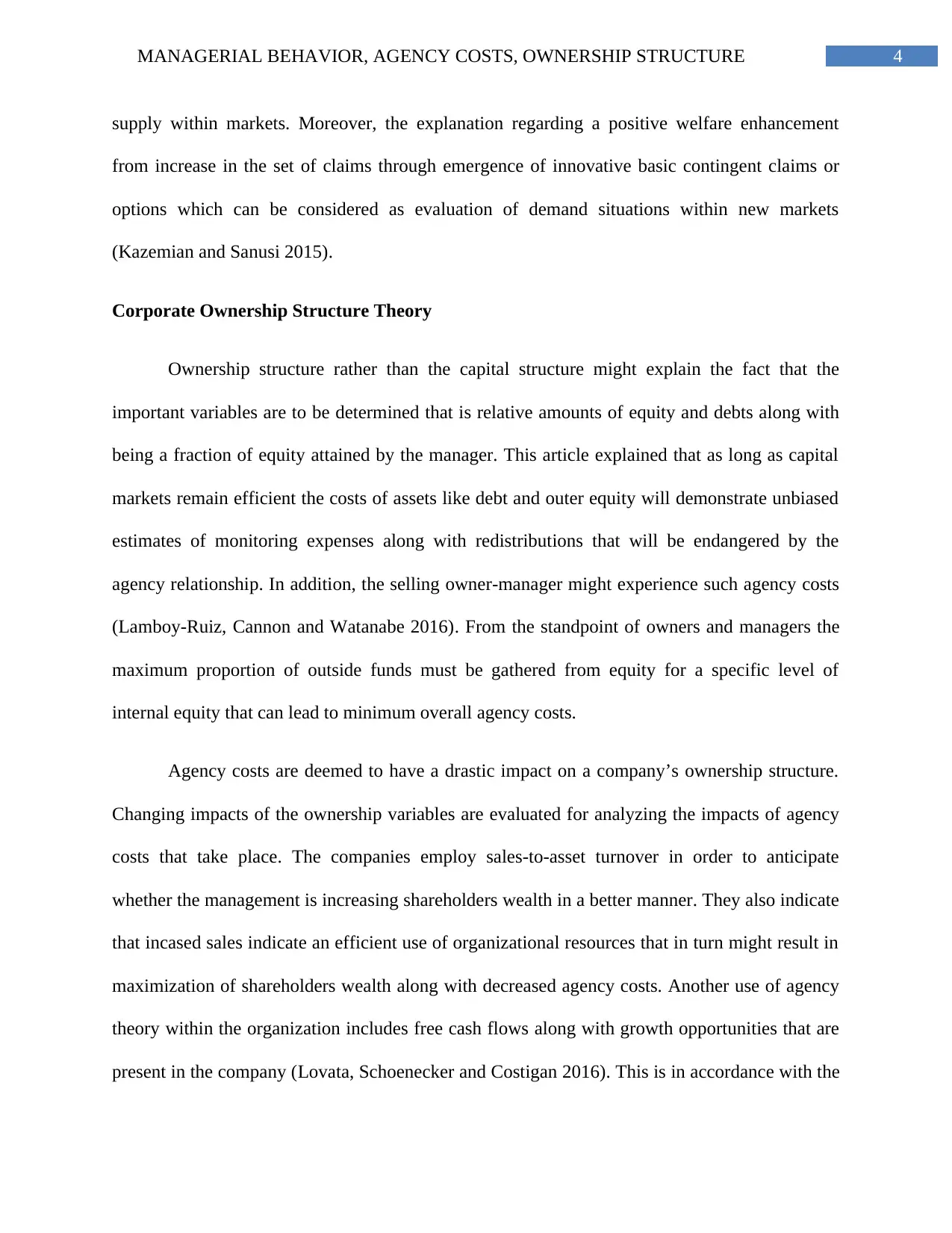
4MANAGERIAL BEHAVIOR, AGENCY COSTS, OWNERSHIP STRUCTURE
supply within markets. Moreover, the explanation regarding a positive welfare enhancement
from increase in the set of claims through emergence of innovative basic contingent claims or
options which can be considered as evaluation of demand situations within new markets
(Kazemian and Sanusi 2015).
Corporate Ownership Structure Theory
Ownership structure rather than the capital structure might explain the fact that the
important variables are to be determined that is relative amounts of equity and debts along with
being a fraction of equity attained by the manager. This article explained that as long as capital
markets remain efficient the costs of assets like debt and outer equity will demonstrate unbiased
estimates of monitoring expenses along with redistributions that will be endangered by the
agency relationship. In addition, the selling owner-manager might experience such agency costs
(Lamboy-Ruiz, Cannon and Watanabe 2016). From the standpoint of owners and managers the
maximum proportion of outside funds must be gathered from equity for a specific level of
internal equity that can lead to minimum overall agency costs.
Agency costs are deemed to have a drastic impact on a company’s ownership structure.
Changing impacts of the ownership variables are evaluated for analyzing the impacts of agency
costs that take place. The companies employ sales-to-asset turnover in order to anticipate
whether the management is increasing shareholders wealth in a better manner. They also indicate
that incased sales indicate an efficient use of organizational resources that in turn might result in
maximization of shareholders wealth along with decreased agency costs. Another use of agency
theory within the organization includes free cash flows along with growth opportunities that are
present in the company (Lovata, Schoenecker and Costigan 2016). This is in accordance with the
supply within markets. Moreover, the explanation regarding a positive welfare enhancement
from increase in the set of claims through emergence of innovative basic contingent claims or
options which can be considered as evaluation of demand situations within new markets
(Kazemian and Sanusi 2015).
Corporate Ownership Structure Theory
Ownership structure rather than the capital structure might explain the fact that the
important variables are to be determined that is relative amounts of equity and debts along with
being a fraction of equity attained by the manager. This article explained that as long as capital
markets remain efficient the costs of assets like debt and outer equity will demonstrate unbiased
estimates of monitoring expenses along with redistributions that will be endangered by the
agency relationship. In addition, the selling owner-manager might experience such agency costs
(Lamboy-Ruiz, Cannon and Watanabe 2016). From the standpoint of owners and managers the
maximum proportion of outside funds must be gathered from equity for a specific level of
internal equity that can lead to minimum overall agency costs.
Agency costs are deemed to have a drastic impact on a company’s ownership structure.
Changing impacts of the ownership variables are evaluated for analyzing the impacts of agency
costs that take place. The companies employ sales-to-asset turnover in order to anticipate
whether the management is increasing shareholders wealth in a better manner. They also indicate
that incased sales indicate an efficient use of organizational resources that in turn might result in
maximization of shareholders wealth along with decreased agency costs. Another use of agency
theory within the organization includes free cash flows along with growth opportunities that are
present in the company (Lovata, Schoenecker and Costigan 2016). This is in accordance with the
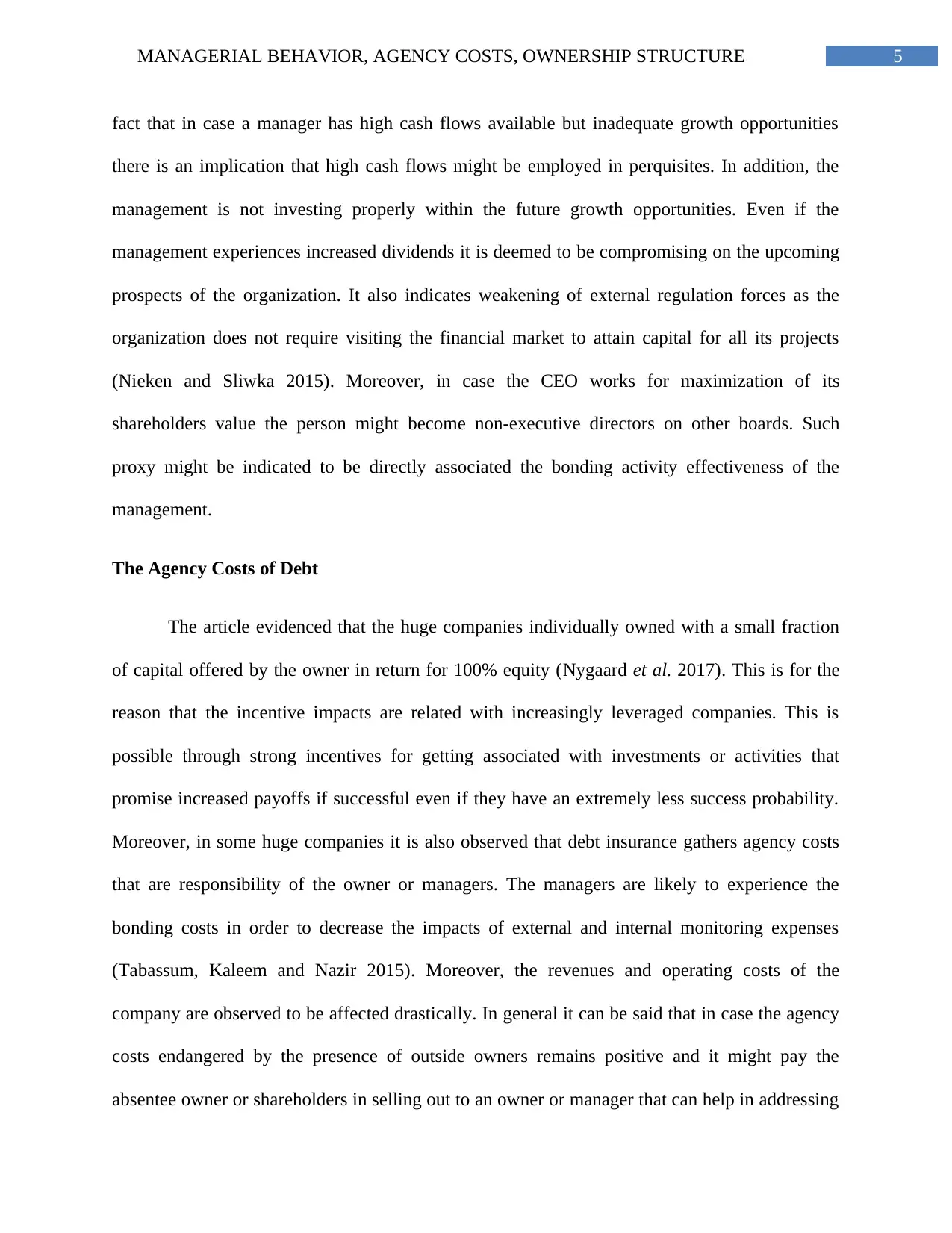
5MANAGERIAL BEHAVIOR, AGENCY COSTS, OWNERSHIP STRUCTURE
fact that in case a manager has high cash flows available but inadequate growth opportunities
there is an implication that high cash flows might be employed in perquisites. In addition, the
management is not investing properly within the future growth opportunities. Even if the
management experiences increased dividends it is deemed to be compromising on the upcoming
prospects of the organization. It also indicates weakening of external regulation forces as the
organization does not require visiting the financial market to attain capital for all its projects
(Nieken and Sliwka 2015). Moreover, in case the CEO works for maximization of its
shareholders value the person might become non-executive directors on other boards. Such
proxy might be indicated to be directly associated the bonding activity effectiveness of the
management.
The Agency Costs of Debt
The article evidenced that the huge companies individually owned with a small fraction
of capital offered by the owner in return for 100% equity (Nygaard et al. 2017). This is for the
reason that the incentive impacts are related with increasingly leveraged companies. This is
possible through strong incentives for getting associated with investments or activities that
promise increased payoffs if successful even if they have an extremely less success probability.
Moreover, in some huge companies it is also observed that debt insurance gathers agency costs
that are responsibility of the owner or managers. The managers are likely to experience the
bonding costs in order to decrease the impacts of external and internal monitoring expenses
(Tabassum, Kaleem and Nazir 2015). Moreover, the revenues and operating costs of the
company are observed to be affected drastically. In general it can be said that in case the agency
costs endangered by the presence of outside owners remains positive and it might pay the
absentee owner or shareholders in selling out to an owner or manager that can help in addressing
fact that in case a manager has high cash flows available but inadequate growth opportunities
there is an implication that high cash flows might be employed in perquisites. In addition, the
management is not investing properly within the future growth opportunities. Even if the
management experiences increased dividends it is deemed to be compromising on the upcoming
prospects of the organization. It also indicates weakening of external regulation forces as the
organization does not require visiting the financial market to attain capital for all its projects
(Nieken and Sliwka 2015). Moreover, in case the CEO works for maximization of its
shareholders value the person might become non-executive directors on other boards. Such
proxy might be indicated to be directly associated the bonding activity effectiveness of the
management.
The Agency Costs of Debt
The article evidenced that the huge companies individually owned with a small fraction
of capital offered by the owner in return for 100% equity (Nygaard et al. 2017). This is for the
reason that the incentive impacts are related with increasingly leveraged companies. This is
possible through strong incentives for getting associated with investments or activities that
promise increased payoffs if successful even if they have an extremely less success probability.
Moreover, in some huge companies it is also observed that debt insurance gathers agency costs
that are responsibility of the owner or managers. The managers are likely to experience the
bonding costs in order to decrease the impacts of external and internal monitoring expenses
(Tabassum, Kaleem and Nazir 2015). Moreover, the revenues and operating costs of the
company are observed to be affected drastically. In general it can be said that in case the agency
costs endangered by the presence of outside owners remains positive and it might pay the
absentee owner or shareholders in selling out to an owner or manager that can help in addressing
⊘ This is a preview!⊘
Do you want full access?
Subscribe today to unlock all pages.

Trusted by 1+ million students worldwide
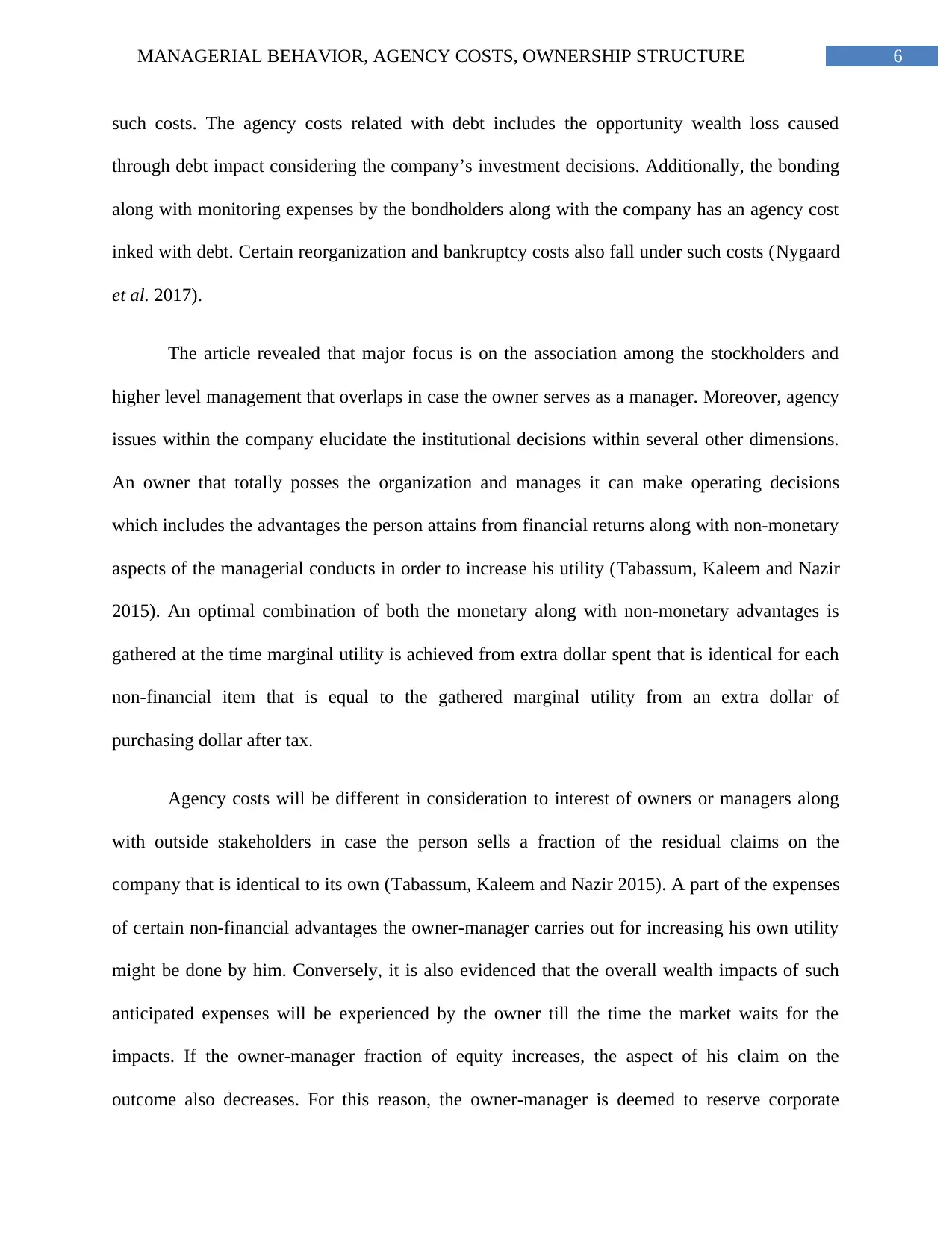
6MANAGERIAL BEHAVIOR, AGENCY COSTS, OWNERSHIP STRUCTURE
such costs. The agency costs related with debt includes the opportunity wealth loss caused
through debt impact considering the company’s investment decisions. Additionally, the bonding
along with monitoring expenses by the bondholders along with the company has an agency cost
inked with debt. Certain reorganization and bankruptcy costs also fall under such costs (Nygaard
et al. 2017).
The article revealed that major focus is on the association among the stockholders and
higher level management that overlaps in case the owner serves as a manager. Moreover, agency
issues within the company elucidate the institutional decisions within several other dimensions.
An owner that totally posses the organization and manages it can make operating decisions
which includes the advantages the person attains from financial returns along with non-monetary
aspects of the managerial conducts in order to increase his utility (Tabassum, Kaleem and Nazir
2015). An optimal combination of both the monetary along with non-monetary advantages is
gathered at the time marginal utility is achieved from extra dollar spent that is identical for each
non-financial item that is equal to the gathered marginal utility from an extra dollar of
purchasing dollar after tax.
Agency costs will be different in consideration to interest of owners or managers along
with outside stakeholders in case the person sells a fraction of the residual claims on the
company that is identical to its own (Tabassum, Kaleem and Nazir 2015). A part of the expenses
of certain non-financial advantages the owner-manager carries out for increasing his own utility
might be done by him. Conversely, it is also evidenced that the overall wealth impacts of such
anticipated expenses will be experienced by the owner till the time the market waits for the
impacts. If the owner-manager fraction of equity increases, the aspect of his claim on the
outcome also decreases. For this reason, the owner-manager is deemed to reserve corporate
such costs. The agency costs related with debt includes the opportunity wealth loss caused
through debt impact considering the company’s investment decisions. Additionally, the bonding
along with monitoring expenses by the bondholders along with the company has an agency cost
inked with debt. Certain reorganization and bankruptcy costs also fall under such costs (Nygaard
et al. 2017).
The article revealed that major focus is on the association among the stockholders and
higher level management that overlaps in case the owner serves as a manager. Moreover, agency
issues within the company elucidate the institutional decisions within several other dimensions.
An owner that totally posses the organization and manages it can make operating decisions
which includes the advantages the person attains from financial returns along with non-monetary
aspects of the managerial conducts in order to increase his utility (Tabassum, Kaleem and Nazir
2015). An optimal combination of both the monetary along with non-monetary advantages is
gathered at the time marginal utility is achieved from extra dollar spent that is identical for each
non-financial item that is equal to the gathered marginal utility from an extra dollar of
purchasing dollar after tax.
Agency costs will be different in consideration to interest of owners or managers along
with outside stakeholders in case the person sells a fraction of the residual claims on the
company that is identical to its own (Tabassum, Kaleem and Nazir 2015). A part of the expenses
of certain non-financial advantages the owner-manager carries out for increasing his own utility
might be done by him. Conversely, it is also evidenced that the overall wealth impacts of such
anticipated expenses will be experienced by the owner till the time the market waits for the
impacts. If the owner-manager fraction of equity increases, the aspect of his claim on the
outcome also decreases. For this reason, the owner-manager is deemed to reserve corporate
Paraphrase This Document
Need a fresh take? Get an instant paraphrase of this document with our AI Paraphraser
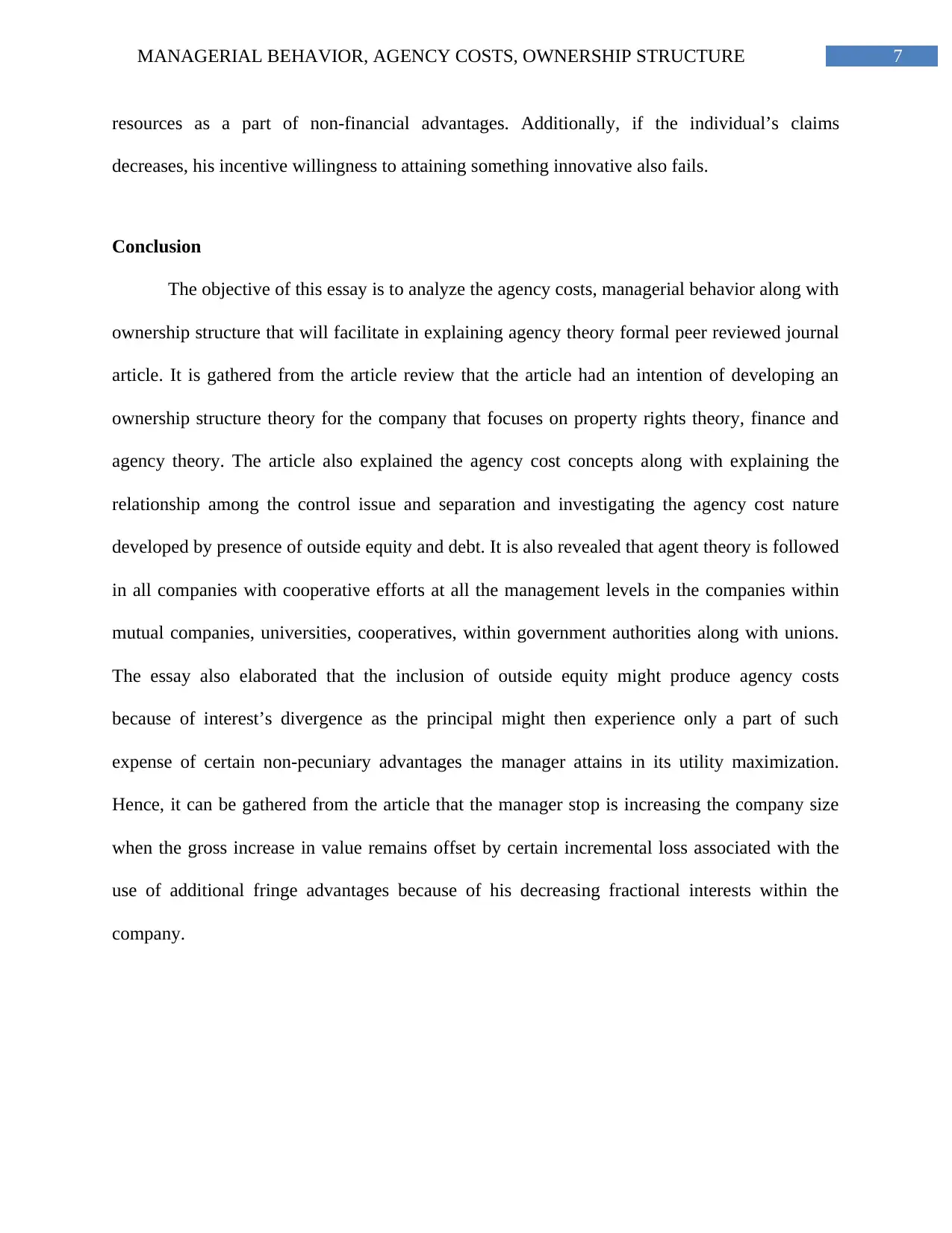
7MANAGERIAL BEHAVIOR, AGENCY COSTS, OWNERSHIP STRUCTURE
resources as a part of non-financial advantages. Additionally, if the individual’s claims
decreases, his incentive willingness to attaining something innovative also fails.
Conclusion
The objective of this essay is to analyze the agency costs, managerial behavior along with
ownership structure that will facilitate in explaining agency theory formal peer reviewed journal
article. It is gathered from the article review that the article had an intention of developing an
ownership structure theory for the company that focuses on property rights theory, finance and
agency theory. The article also explained the agency cost concepts along with explaining the
relationship among the control issue and separation and investigating the agency cost nature
developed by presence of outside equity and debt. It is also revealed that agent theory is followed
in all companies with cooperative efforts at all the management levels in the companies within
mutual companies, universities, cooperatives, within government authorities along with unions.
The essay also elaborated that the inclusion of outside equity might produce agency costs
because of interest’s divergence as the principal might then experience only a part of such
expense of certain non-pecuniary advantages the manager attains in its utility maximization.
Hence, it can be gathered from the article that the manager stop is increasing the company size
when the gross increase in value remains offset by certain incremental loss associated with the
use of additional fringe advantages because of his decreasing fractional interests within the
company.
resources as a part of non-financial advantages. Additionally, if the individual’s claims
decreases, his incentive willingness to attaining something innovative also fails.
Conclusion
The objective of this essay is to analyze the agency costs, managerial behavior along with
ownership structure that will facilitate in explaining agency theory formal peer reviewed journal
article. It is gathered from the article review that the article had an intention of developing an
ownership structure theory for the company that focuses on property rights theory, finance and
agency theory. The article also explained the agency cost concepts along with explaining the
relationship among the control issue and separation and investigating the agency cost nature
developed by presence of outside equity and debt. It is also revealed that agent theory is followed
in all companies with cooperative efforts at all the management levels in the companies within
mutual companies, universities, cooperatives, within government authorities along with unions.
The essay also elaborated that the inclusion of outside equity might produce agency costs
because of interest’s divergence as the principal might then experience only a part of such
expense of certain non-pecuniary advantages the manager attains in its utility maximization.
Hence, it can be gathered from the article that the manager stop is increasing the company size
when the gross increase in value remains offset by certain incremental loss associated with the
use of additional fringe advantages because of his decreasing fractional interests within the
company.
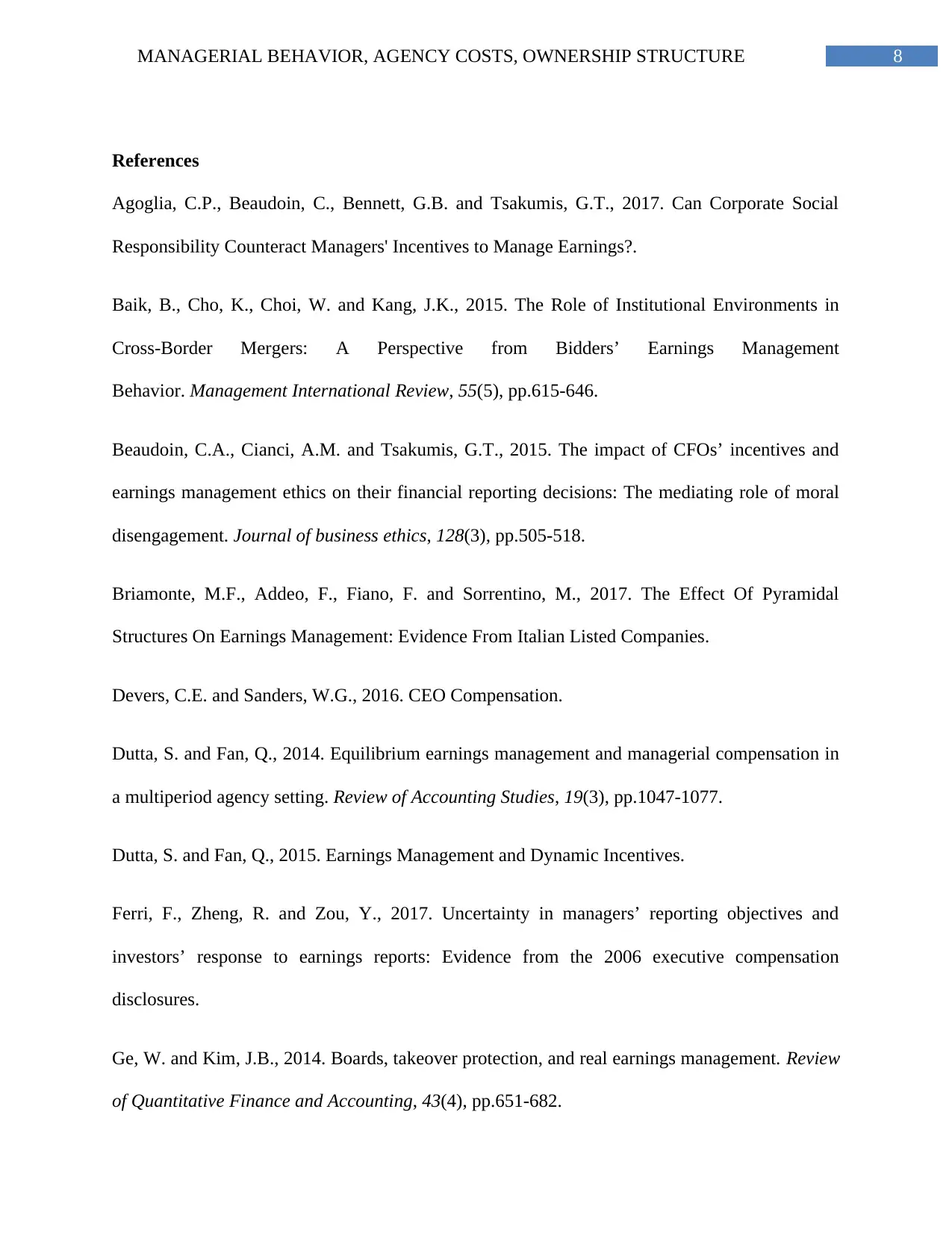
8MANAGERIAL BEHAVIOR, AGENCY COSTS, OWNERSHIP STRUCTURE
References
Agoglia, C.P., Beaudoin, C., Bennett, G.B. and Tsakumis, G.T., 2017. Can Corporate Social
Responsibility Counteract Managers' Incentives to Manage Earnings?.
Baik, B., Cho, K., Choi, W. and Kang, J.K., 2015. The Role of Institutional Environments in
Cross-Border Mergers: A Perspective from Bidders’ Earnings Management
Behavior. Management International Review, 55(5), pp.615-646.
Beaudoin, C.A., Cianci, A.M. and Tsakumis, G.T., 2015. The impact of CFOs’ incentives and
earnings management ethics on their financial reporting decisions: The mediating role of moral
disengagement. Journal of business ethics, 128(3), pp.505-518.
Briamonte, M.F., Addeo, F., Fiano, F. and Sorrentino, M., 2017. The Effect Of Pyramidal
Structures On Earnings Management: Evidence From Italian Listed Companies.
Devers, C.E. and Sanders, W.G., 2016. CEO Compensation.
Dutta, S. and Fan, Q., 2014. Equilibrium earnings management and managerial compensation in
a multiperiod agency setting. Review of Accounting Studies, 19(3), pp.1047-1077.
Dutta, S. and Fan, Q., 2015. Earnings Management and Dynamic Incentives.
Ferri, F., Zheng, R. and Zou, Y., 2017. Uncertainty in managers’ reporting objectives and
investors’ response to earnings reports: Evidence from the 2006 executive compensation
disclosures.
Ge, W. and Kim, J.B., 2014. Boards, takeover protection, and real earnings management. Review
of Quantitative Finance and Accounting, 43(4), pp.651-682.
References
Agoglia, C.P., Beaudoin, C., Bennett, G.B. and Tsakumis, G.T., 2017. Can Corporate Social
Responsibility Counteract Managers' Incentives to Manage Earnings?.
Baik, B., Cho, K., Choi, W. and Kang, J.K., 2015. The Role of Institutional Environments in
Cross-Border Mergers: A Perspective from Bidders’ Earnings Management
Behavior. Management International Review, 55(5), pp.615-646.
Beaudoin, C.A., Cianci, A.M. and Tsakumis, G.T., 2015. The impact of CFOs’ incentives and
earnings management ethics on their financial reporting decisions: The mediating role of moral
disengagement. Journal of business ethics, 128(3), pp.505-518.
Briamonte, M.F., Addeo, F., Fiano, F. and Sorrentino, M., 2017. The Effect Of Pyramidal
Structures On Earnings Management: Evidence From Italian Listed Companies.
Devers, C.E. and Sanders, W.G., 2016. CEO Compensation.
Dutta, S. and Fan, Q., 2014. Equilibrium earnings management and managerial compensation in
a multiperiod agency setting. Review of Accounting Studies, 19(3), pp.1047-1077.
Dutta, S. and Fan, Q., 2015. Earnings Management and Dynamic Incentives.
Ferri, F., Zheng, R. and Zou, Y., 2017. Uncertainty in managers’ reporting objectives and
investors’ response to earnings reports: Evidence from the 2006 executive compensation
disclosures.
Ge, W. and Kim, J.B., 2014. Boards, takeover protection, and real earnings management. Review
of Quantitative Finance and Accounting, 43(4), pp.651-682.
⊘ This is a preview!⊘
Do you want full access?
Subscribe today to unlock all pages.

Trusted by 1+ million students worldwide
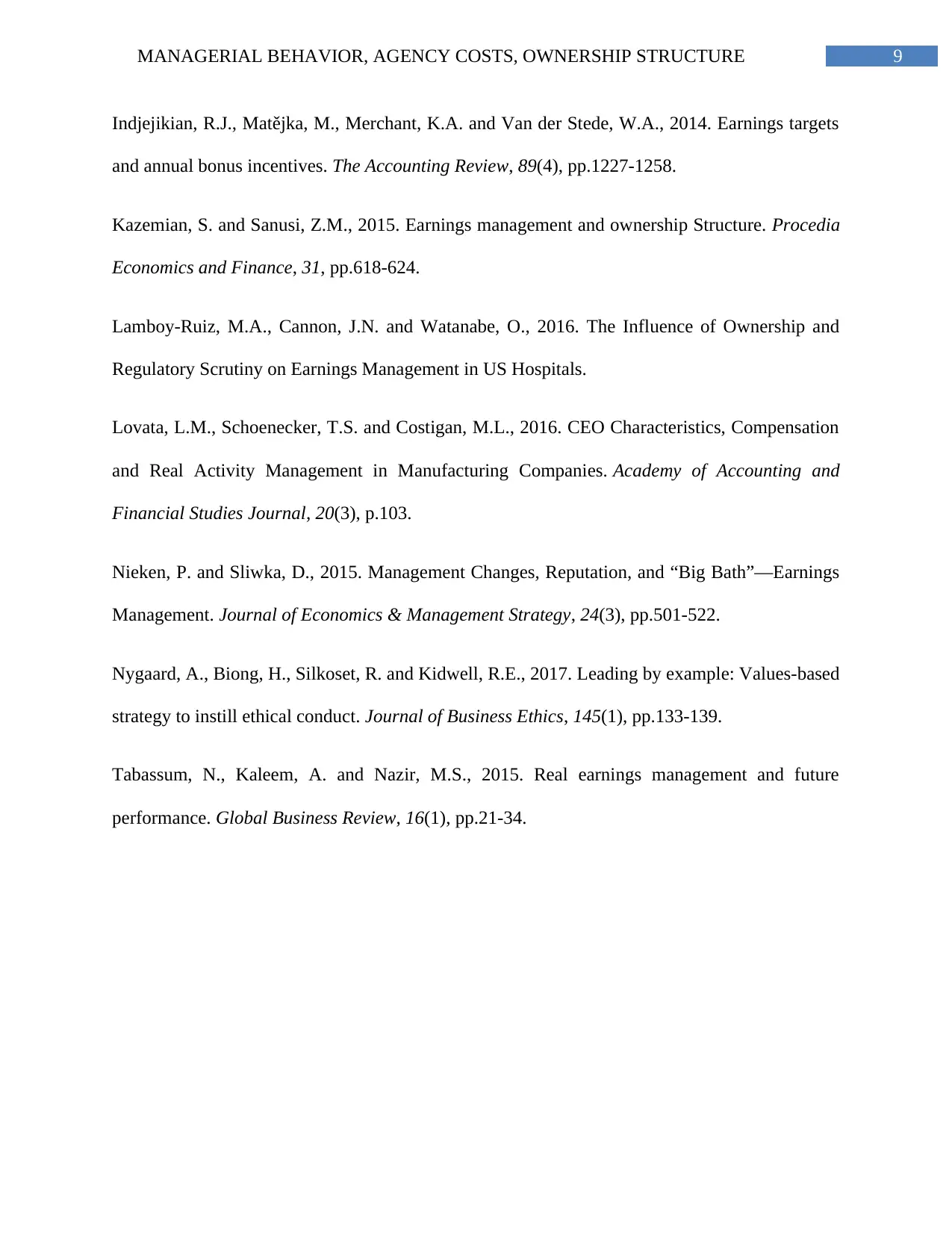
9MANAGERIAL BEHAVIOR, AGENCY COSTS, OWNERSHIP STRUCTURE
Indjejikian, R.J., Matějka, M., Merchant, K.A. and Van der Stede, W.A., 2014. Earnings targets
and annual bonus incentives. The Accounting Review, 89(4), pp.1227-1258.
Kazemian, S. and Sanusi, Z.M., 2015. Earnings management and ownership Structure. Procedia
Economics and Finance, 31, pp.618-624.
Lamboy-Ruiz, M.A., Cannon, J.N. and Watanabe, O., 2016. The Influence of Ownership and
Regulatory Scrutiny on Earnings Management in US Hospitals.
Lovata, L.M., Schoenecker, T.S. and Costigan, M.L., 2016. CEO Characteristics, Compensation
and Real Activity Management in Manufacturing Companies. Academy of Accounting and
Financial Studies Journal, 20(3), p.103.
Nieken, P. and Sliwka, D., 2015. Management Changes, Reputation, and “Big Bath”—Earnings
Management. Journal of Economics & Management Strategy, 24(3), pp.501-522.
Nygaard, A., Biong, H., Silkoset, R. and Kidwell, R.E., 2017. Leading by example: Values-based
strategy to instill ethical conduct. Journal of Business Ethics, 145(1), pp.133-139.
Tabassum, N., Kaleem, A. and Nazir, M.S., 2015. Real earnings management and future
performance. Global Business Review, 16(1), pp.21-34.
Indjejikian, R.J., Matějka, M., Merchant, K.A. and Van der Stede, W.A., 2014. Earnings targets
and annual bonus incentives. The Accounting Review, 89(4), pp.1227-1258.
Kazemian, S. and Sanusi, Z.M., 2015. Earnings management and ownership Structure. Procedia
Economics and Finance, 31, pp.618-624.
Lamboy-Ruiz, M.A., Cannon, J.N. and Watanabe, O., 2016. The Influence of Ownership and
Regulatory Scrutiny on Earnings Management in US Hospitals.
Lovata, L.M., Schoenecker, T.S. and Costigan, M.L., 2016. CEO Characteristics, Compensation
and Real Activity Management in Manufacturing Companies. Academy of Accounting and
Financial Studies Journal, 20(3), p.103.
Nieken, P. and Sliwka, D., 2015. Management Changes, Reputation, and “Big Bath”—Earnings
Management. Journal of Economics & Management Strategy, 24(3), pp.501-522.
Nygaard, A., Biong, H., Silkoset, R. and Kidwell, R.E., 2017. Leading by example: Values-based
strategy to instill ethical conduct. Journal of Business Ethics, 145(1), pp.133-139.
Tabassum, N., Kaleem, A. and Nazir, M.S., 2015. Real earnings management and future
performance. Global Business Review, 16(1), pp.21-34.
1 out of 10
Related Documents
Your All-in-One AI-Powered Toolkit for Academic Success.
+13062052269
info@desklib.com
Available 24*7 on WhatsApp / Email
![[object Object]](/_next/static/media/star-bottom.7253800d.svg)
Unlock your academic potential
Copyright © 2020–2025 A2Z Services. All Rights Reserved. Developed and managed by ZUCOL.





